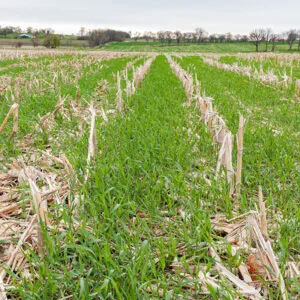Fall may signal a time of rest is on the horizon, but for a field’s soil, it’s time to rebuild. Fall soil assessments and sampling can provide insights into soil health so growers can work with an expert to devise a plan that revitalizes the soil microbiome.

Healthy soil is the foundation for strong crop growth and influences ROI each season. Without the right below-ground environment and structure, soil can’t support maximum plant performance of today’s high-yielding crop genetics.
The first step is to assess physical soil properties, which affect water infiltration, soil erosion, nutrient cycling and biologic activity within the soil.
“Put a shovel into the soil so you can examine the texture, see the color and check the smell,” explained Gina Colfer, key account manager for Organics with Wilbur-Ellis Agribusiness and 35-year veteran working across all farm systems.
Healthy soil should smell earthy, which signals that actinomycetes—beneficial soil bacteria—are present and doing their job. A rancid smell means there’s a problem, she noted.
Soil that’s a darker color shows a healthy amount of organic matter is present, while soil that’s trending white needs to have more organic matter added.
Other physical soil properties include structure, porosity, density and consistency, aggregate stability and temperature.

Still in its early stages, understanding soil biology can help identify negative microbes that cause disease and plant damage, as well as beneficial microbes that stimulate plant growth and solubilize nutrients. Biological soil testing companies like Trace Genomics™ measure different types of soil microbes that can help yield positive responses.
Building a soil health plan
The team at Wilbur-Ellis will help growers break-down the physical, chemical and biological data to create a sound soil health plan focused on increasing organic matter and improving the soil microbiome. Some practices, such as adjusting soil fertility and planting cover crops, can begin this fall.
1. Soil fertility
“Establishing good fertility is probably the first thing one can do to maintain good soil health,” said Carl Bruice, national nutrition technical manager for Wilbur-Ellis. “Fertility impacts soil health by stimulating production of organic matter, the energy source for soil microbes, which are very viable components of soil health.”
By increasing soil organic matter, growers also improve the soil’s water-holding capacity and the cation exchange capacity, two important properties influencing soil structure stability and nutrient availability. As more natural fertility is built within the soil, it potentially reduces the need for supplemental fertilizer.
“Proper fertilization practices—knowing your crop’s nutrient demand curves and applying nutrients timed at peak demand to minimize waste and maximize nutrient uptake efficiency—are very important. Good fertility practices maximize production to the grower’s benefit and to the overall quality of the soil,” Bruice added.
2. Cover crops
Another way to improve soil structure and microbial activity is to add cover crops to crop production practices. Properly planned and executed, cover crops reduce soil erosion and run-off, and increase water infiltration. Over time, cover crops will also increase soil organic matter, leading to improved stability and nutrient-holding capacity for plant growth. Organic matter further serves as a high-quality food source for soil microbes. These microbes break down organic matter and feed it to the plant to support healthy growth.
“With roots in the soil year-round, cover cropping can enhance soil microbial activity, helping to improve soil structure,” explained Greg Binford, director of advanced agronomy training, Wilbur-Ellis. “Crop rotation does the same thing, giving you greater diversity of microbes and helping to reduce diseases that can build up when growing the same crop year after year.”
Along with providing organic matter, the right cover crop will help sequester carbon within soil because it pulls in carbon dioxide from the air as it grows, releasing carbon into the soil in the form of carbohydrates.
“Cover crops are probably putting about 25 percent of the total carbon back into the soil to feed the microbes,” Colfer noted.
3. Reduced tillage
When it comes time to incorporate your cover crop, keeping tillage to a minimum is beneficial for soil health. In fields where corn or soybeans will be planted, cover crops can be mowed, burned down with a herbicide or killed with a crimper before planting directly into cover crop residue. However, different tillage methods are required in vegetable programs that require a clean planting bed.
“Tillage equipment degrades soil structure by removing residue from the surface layer,” Binford explained. “By adopting reduced till and no-till practices, a producer can decrease residue decomposition and increase soil organic matter. And organic matter is very important to good soil structure.
More organic matter also allows better oxygen levels in the soil, which is important for soil microbes.

Contact a Wilbur-Ellis expert to gain insights into your soil and build a plan to bolster soil health that fits your farm’s needs.

